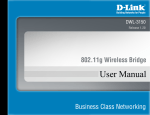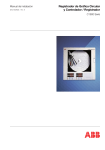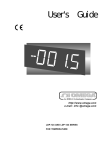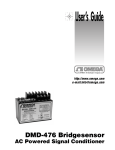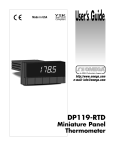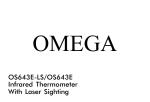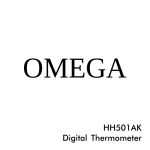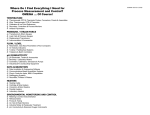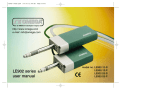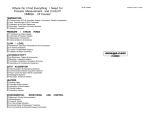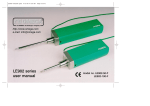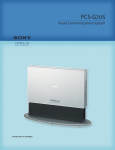Download Omega CN3440 User's Manual
Transcript
User’s Guide omega.com ® ® http://www.omega.com e-mail: [email protected] CN3440 SERIES Universal Temperature & Process Controllers Installation Guide WARRANTY/DISCLAIMER OMEGA ENGINEERING, INC. warrants this unit to be free of defects in materials and workmanship for a period of 37 months from date of purchase. OMEGA Warranty adds an additional one (1) month grace period to the normal three (3) year product warranty to cover handling and shipping time. This ensures that OMEGA’s customers receive maximum coverage on each product. If the unit malfunctions, it must be returned to the factory for evaluation. OMEGA’s Customer Service Department will issue an Authorized Return (AR) number immediately upon phone or written request. Upon examination by OMEGA, if the unit is found to be defective, it will be repaired or replaced at no charge. OMEGA’s WARRANTY does not apply to defects resulting from any action of the purchaser, including but not limited to mishandling, improper interfacing, operation outside of design limits, improper repair, or unauthorized modification. This WARRANTY is VOID if the unit shows evidence of having been tampered with or shows evidence of having been damaged as a result of excessive corrosion; or current, heat, moisture or vibration; improper specification; misapplication; misuse or other operating conditions outside of OMEGA’s control. Components which wear are not warranted, including but not limited tocontact points, fuses, and triacs. OMEGA is pleased to offer suggestions on the use of its various products. However, OMEGA neither assumes responsibility for any omissions or errors nor assumes liability for any damages that result from the use of its products in accordance with information provided by OMEGA, either verbal or written. OMEGA warrants only that the parts manufactured by it will be as specified and free of defects. OMEGA MAKES NO OTHER WARRANTIES OR REPRESENTATIONS OF ANY KIND WHATSOEVER, EXPRESS OR IMPLIED, EXCEPT THAT OF TITLE, AND ALL IMPLIED WARRANTIES INCLUDING ANY WARRANTY OF MERCHANTABILITY AND FITNESS FOR A PARTICULAR PURPOSE ARE HEREBY DISCLAIMED. LIMITATION OF LIABILITY: The remedies of purchaser set forth herein are exclusive, and the total liability of OMEGA with respect to this order, whether based on contract, warranty, negligence, indemnification, strict liability or otherwise, shall not exceed the purchase price of the component upon which liability is based. In no event shall OMEGA be liable for consequential, incidental or special damages. CONDITIONS: Equipment sold by OMEGA is not intended to be used, nor shall it be used: (1) as a “Basic Component” under 10 CFR 21 (NRC), used in or with any nuclear installation or activity; or (2) in medical applications or used on humans. Should any Product(s) be used in or with any nuclear installation or activity, medical application, used on humans, or misused in any way, OMEGA assumes no responsibility as set forth in our basic WARRANTY / DISCLAIMER language, and, additionally, purchaser will indemnify OMEGA and hold OMEGA harmless from any liability or damage whatsoever arising out of the use of the Product(s) in such a manner. RETURN REQUESTS / INQUIRIES Direct all warranty and repair requests/inquiries to the OMEGA Customer Service Department. BEFORE RETURNING ANY PRODUCT(S) TO OMEGA, PURCHASER MUST OBTAIN AN AUTHORIZED RETURN (AR) NUMBER FROM OMEGA’S CUSTOMER SERVICE DEPARTMENT (IN ORDER TO AVOID PROCESSING DELAYS). The assigned AR number should then be marked on the outside of the return package and on any correspondence. The purchaser is responsible for shipping charges, freight, insurance and proper packaging to prevent breakage in transit. FOR WARRANTY RETURNS, please have the following information available BEFORE contacting OMEGA: 1. Purchase Order number under which the product was PURCHASED, 2. Model and serial number of the product under warranty, and 3. Repair instructions and/or specific problems relative to the product. FOR NON-WARRANTY REPAIRS, consult OMEGA for current repair charges. Have the following information available BEFORE contacting OMEGA: 1. Purchase Order number to cover the COST of the repair, 2. Model and serial number of the product, and 3. Repair instructions and/or specific problems relative to the product. OMEGA’s policy is to make running changes, not model changes, whenever an improvement is possible. This affords our customers the latest in technology and engineering. OMEGA is a registered trademark of OMEGA ENGINEERING, INC. © Copyright 1998 OMEGA ENGINEERING, INC. All rights reserved. This document may not be copied, photocopied, reproduced, translated, or reduced to any electronic medium or machine-readable form, in whole or in part, without the prior written consent of OMEGA ENGINEERING, INC. CONTENTS 1 INTRODUCTION .................................. 2 2 PREPARATION .................................... 3 2.1 Checking the Code Number ......... 3 3 MECHANICAL INSTALLATION .......... 4 3.1 Siting .......................................... 4 3.2 Mounting ...................................... 5 4 ELECTRICAL INSTALLATION ............ 6 4.1 Access to Terminals ..................... 6 4.2 Setting the Input Selector Links ... 6 4.3 Setting the Isolated Output Link ... 6 4.4 Cable Glands and Conduit Fixings ............................ 8 4.4.1 Cable Glands (IEC – 20mm) ................... 8 4.4.2 Conduit Adaptors (N. American – 0.5in) ........ 8 4.4.3 Cable Glands (N. American – 0.5in) ........ 9 4.5 Connections Summary ............... 10 4.6 Input Connections ...................... 12 4.6.1 Thermocouple (THC) Inputs ................... 12 4.6.2 3-lead Resistance Thermometer (RTD) Inputs .............................. 12 4.6.3 2-lead Resistance Thermometer (RTD) Inputs .............................. 12 4.6.4 Links for Unused Inputs .. 12 4.7 Output Connections ................... 14 4.8 Relay Connections ..................... 14 4.9 Motorized Valve Connections .... 14 4.10 Logic Input Connections ............ 15 4.11 Power Supply Selection and AC Connections ......................... 16 5 INSTALLATION RECORD ................. 17 1 1 INTRODUCTION The instrument documentation is shown in Fig. 1.1. The Standard Manuals, including the specification sheet, are supplied with all instruments. The Modbus Supplement is supplied with instruments configured for Modbus Serial Communication. This manual includes an Installation Record which should be completed as a log of the electrical installation. The record is useful when carrying out initial instrument programming and can be retained for future reference. INSTALLATION Product Identification Siting Mounting Electrical Connections Installation Record PROGRAMMING MODBUS (RTU). Basic Config. Level Operating Level Serial Adaptors Serial Connections Programming Page Simple Fault-Finding MODBUS Registers OPERATION Setting Up Displays & Controls Advanced Config. Level Standard Manuals Fig. 1.1 Documentation 2 MODBUS Supplement 2 2.1 PREPARATION Checking the Code Number – Fig. 2.1 XXXX / X X X X X X X X Code Number Label Fig. 2.1 Location of Code Number Label 3 3 MECHANICAL INSTALLATION EC Directive 89/336/EEC In order to meet the requirements of the EC Directive 89/336/EEC for EMC regulations, this product must not be used in a non-industrial environment. 3.1 Siting – Figs. 3.1 and 3.2 Minimum 55°C Max. 0°C Min. A – Within Temperature Limits 0 to 90% RH Sensor A – Close to Sensor B – Within Humidity Limits IP66/ NEMA4X B – At Eye-level Location C – Within Protection Rating Limits + C – Avoid Vibration Fig. 3.1 General Requirements Caution. Select a location away from strong electrical and magnetic fields. If these cannot be avoided, particularly in applications where ‘walkie talkies’ are used, connect using screened cables within earthed metal conduit. D – Use Screened Cables Fig. 3.2 Environmental Requirements 4 3 3.2 MECHANICAL INSTALLATION… Mounting – Figs. 3.3 and 3.4 The instrument is designed for wall-/pipe-mounting – see Fig. 3.4. Overall dimensions are shown in Fig. 3.3. Dimensions in inches (mm) 1.65 (42) Fixing Centres 2.68 (68) 6.3 (160) 8.43 (214) 9.84 (250) 2.72 (69) 7.9 (200) Fixing Centres Allowance for Cable Bends 9.13 (232) 23/8 (61) O.D. Vertical or Horizontal Post Fixing Holes (x3) 0.25 (6.5) Dia Fig. 3.3 Overall Dimensions 2 Drill suitable holes Position ‘U’ bolts on pipe 1 Position plates over ‘U’ bolts 2 Pipe Mounting Kit 1 Mark fixing centres (see Fig. 3.3) 3 Secure plates 3 Fix instrument to wall using suitable fixing 4 Secure transmitter to mounting plate Fig. 3.4 Wall-/Pipe-mounting Details 5 4 ELECTRICAL INSTALLATION Warning. Before making any connections, ensure that the power supply, any high voltage-operated control circuits and high common mode voltages are switched off. • • Note. Always route signal leads and power cables separately, preferably in earthed metal conduit. It is strongly recommended that screened cable is used for signal inputs and relay connections. Connect the screen to the ground stud. Information. Use cable appropriate for the load currents. The terminals accept cables up 12AWG (2.5mm2). 4.1 Access to Terminals – Fig. 4.1 For access to terminals – refer to Fig. 4.1, steps 1 to 3. 4.2 Setting the Selector Links – Fig. 4.2A Input Plug-in links on the microprocessor p.c.b. are positioned according to the type of Process Variable Input, Remote Set Point Input and Valve Position Feedback Inputs used. Remove the instrument front panel – see Fig. 4.1, steps 1 to 6. Referring to Fig. 4.2A, set the link positions for the input type required. 4.3 Setting the Output Link – Fig. 4.2B Isolated A plug-in link (PL7) on the microprocessor p.c.b. is positioned according to the isolated output required, either a current proportioning control output (programmable in range 0 to 20mA) or a 12V logic output (minimum load 400Ω). Referring to Fig. 4.2B – steps 1 and 2, set the link for the output type required. To use a 12V logic output, the control type must be set to Time Proportioning Control – see Fig. 3.1 of the Programming Guide. 6 Remove front 5 Remove cap and screw panel 1 slide down 2Pull out 4 Remove front slightly… panel screws 2 …and slide off 3 Slacken captive screws and remove protection cover Fig. 4.1 Access to Terminals and Processor Board 6 4 ELECTRICAL INSTALLATION… 1 Identify Link PL7 2 Set links for output type required PL7 1 Logic Output PL7 1 or Analog Output B – Isolated Output Types 8 5 4 5 4 4 8 PL2 PL3 1 5 4 4 1 PL3 5 8 PL3 5 4 5 8 PL2 1 8 1 6 7 6 7 12 1 PL3 Position Feedback Input 1 8 PL2 1 7 6 7 12 1 PL1 12 PL1 2-wire Transmitter Input 1 V PL2 Remote Set Point Input 6 PL1 R, mV, THC & RTD 1 mA PL1 12 PL1 Process Variable Input A – Input Types Fig. 4.2 Setting the Selector Links 7 …4 ELECTRICAL INSTALLATION 4.4 Cable and Conduit Fixings Glands 4.4.1 Cable (IEC – 20mm) – Fig. 4.3 Glands 4.4.2 Conduit Adaptors (N. American – 0.5in) – Fig. 4.4 • • • • 'O'-Ring Warning. Rigid conduit must NOT be fitted to the controller. Controller adaptors must incorporate a face seal. Torque settings for the hubs and outer nuts on the specified adaptors is 20ft. lbs minimum, 25ft. lbs. maximum. Information. Suitable adaptors for controller (mandatory for FM installations): APPLETON ST-50 PLUS STG-50 or STB-50 PLUS STG-50. Reusable ONLY with replacement ferrule STF-50. O.Z. GEDNEY 4Q-50, 4Q50T or 4Q-50TG. Alternative Face Seal Fig. 4.3 Cable Gland (Supplied as standard) Face Seal Seal (Present in O.Z. Gedney Fittings) Outer Nut Fig. 4.4 Conduit Adaptors 8 Hub Ferrule 4 ELECTRICAL INSTALLATION… 4.4.3 Cable Glands (N. American – 0.5in) – Fig. 4.5 • • • • • Warning. Controller glands must be fitted with a face seal. Torque settings (hubs only) – 20ft. lbs minimum, 25ft. lbs. maximum. Outer nuts – hand tight plus a half turn only. Information. Suitable Cable Glands: (mandatory for FM installations): O.Z. GEDNEY SR-50-375 or SR-504 APPLETON CG 3150 or CG-3150S (and STG50 sealing ring). THOMAS & BETTS 2521. When fitting cable glands to the controller, start with an outer gland and also temporarily fit a gland at the opposite end, to aid location of the transmitter gland plate. Fit and tighten glands consecutively from initial gland. Alternative Face Seal Face Seal Hub Fittings vary slightly for different makes Illustration typical for O.Z.Gedney Outer Nut Fig. 4.5 Cable Glands 9 …4 ELECTRICAL INSTALLATION 4.5 Connections Summary – Fig. 4.6 Information. Input impedances: Low voltage(mV) >10MΩ Voltage >10MΩ Current 10Ω. Relay 1 Relay 3 Process Variable Input Remote Set Point Input Relay 2 Power Supply 3 4 5 6 7 8 9 10 11 12 13 14 15 16 17 1 2 18 19 20 21 22 23 24 25 26 MODBUS (RTU) (if option fitted) 27 28 29 30 31 32 Control Output Logic Input Position Feedback Input Retransmission Output Fig. 4.6 Terminal Block Identification 10 4 ELECTRICAL INSTALLATION… Terminal Number 1 2 AC Supply L 24V, 115V or 230V a.c. N 3 4 5 N/O C N/C Relay 1 Output – see Fig. 4.17 Motorized Valve Control Relay (open) – see Fig. 4.19A 6 7 8 N/O C N/C Relay 2 Output – see Fig. 4.17 Motorized Valve Control Relay (close) – see Fig. 4.19A 9 10 11 N/O C N/C Relay 3 Output – see Fig. 4.17 Alarm Relays 12 13 14 3rd lead/2-wire TX Input 1+ Input 1– Process Variable Input – see Figs. 4.7 to 4.9, 4.12 and 4.14 15 16 17 3rd lead Input 2+ Input 2– Remote Set Point Input – see Figs. 4.7 to 4.12 and 4.14 18 19 20 21 22 Tx+ Tx– Common Rx+ Rx– 23 24 + – Retransmission Output/Cool Output – see Fig. 4.15 25 26 + – Current Proportioning Control Output/Heat Output Fig. 4.15 or 12V Logic Control Output Fig. 4.16 27 28 29 3rd lead Input 3+ Input 3– Position Feedback Input – see Figs. 4.18 , 4.19A and 4.19B 30 31 32 – see Fig. 4.22 or 2-wire Tx Power Supply – see Fig. 4.13 RS 485 Modbus Serial Communications Option 1 only – see Modbus (RTU) Communications Supplement Logic Input 1 – see Figs. 4.20 and 4.21 Logic Input 2 – see Figs. 4.20 and 4.21 Common Table 4.1 Electrical Connections 11 …4 ELECTRICAL INSTALLATION 4.6 Input Connections Make connections to each input, as shown in Figs 4.4 to 4.14, first removing any factory-fitted wire links not required. 4.6.1 Thermocouple (THC) Inputs – Fig. 4.7 Note. Automatic Cold Junction Compensation (ACJC) is active when an input is programmed for use with thermocouples. Use the correct compensating cable between the THC and the terminals – see Table 4.2. If an external fixed cold junction is used, the connections to the instrument must be made with copper cable. The input must be programmed for mV input signals and the appropriate THC linearizer selected – see Sections 4.5 and 4.6 of the Programming Guide. Type of Thermocouple Ni-Cr/Ni-Al (K) Nicrisil/Nisil ( N) Pt/Pt-Rh (R and S) Cu/Cu-Ni (T) Fe/Con (J) Compensating Cable BS1843 + Brown – Blue Case Red + Orange – Blue Case Orange + White – Blue Case Green + White – Blue Case Blue + Yellow – Blue Case Black ANSI MC 96.1 + Yellow – Red Case Yellow + Orange – Red Case Orange + Black – Red Case Green + Blue – Red Case Blue + White – Red Case Black DIN 43714 + Red – Green Case Green — + Red – White Case White + Red – Brown Case Brown + Red – Blue Case Blue BS4937 Part No.30 + Green – White Case Green * + Pink – White Case Pink * + Orange – White Case Orange * + Brown – White Case Brown * + Black – White Case Black * * Case Blue for intrinsically safe circuits Fe/Con (DIN 43710) — — DIN 43710 + Blue/red – Blue Case Blue — Table 4.2 Thermocouple Compensating Cables 4.6.2 3-lead Resistance Thermometer (RTD) Inputs – Fig. 4.8 The three leads must have equal resistance, not exceeding 50Ω each. 4.6.3 2-lead Resistance Thermometer (RTD) Inputs – Fig. 4.9 If long leads are necessary it is preferable to use a 3-lead RTD. If the RTD is to be used in a hazardous area a 3-lead RTD must be used. 4.6.4 Links for Unused Inputs To reduce susceptibility to electro-magnetic interference, ensure that the three terminals on each unused input are shorted together with sleeved wire links. 12 4 % ^ & @ £ $ Sleeved Link + – Fig. 4.7 Thermocouple Input Connections – Fig. 4.12 Current Input Connections @ £$ % ^& @ £$ Red White @ £$ Sleeved Link + Remote Set Point Process Variable % ^& Remote Set Point Process Variable + Remote Set Point Process Variable ELECTRICAL INSTALLATION… Red Tx – Fig. 4.13 2-wire Transmitter Power Supply Input Connections Fig. 4.8 3-lead Resistance Thermometer Input Connections Remote Set Point Process Variable % ^ & @ £ $ Sleeved Link Sleeved Link – Fig. 4.14 Voltage Input Connections Red White Fig. 4.9 2-lead Resistance Thermometer Input Connections % ^& Retransmission O/P or 'Cool' Analogue O/P in Heat/Cool 23 24 25 26 Current Proportioning Control Output + Remote Set Point % ^& @ £$ + Remote Set Point Process Variable Remote Set Point % ^& Sleeved Link Fig. 4.11 2-lead Resistance Remote Set Point Input Connections Fig. 4.15 Current Proportioning Control and Retransmission Output Connections 12V Logic Output for ON/OFF or Time-proportioning Control 25 26 + Fig. 4.10 3-lead Resistance Remote Set Point Input Connections – – Fig. 4.16 Logic Control Output Connections 13 …4 ELECTRICAL INSTALLATION 4.7 Output Connections 3 4 5 67 8 Make connections as shown in Figs 4.15 and 4.16. 4.8 Relay Connections – Fig. 4.17 For relay functions refer to the following table. Relay 1 Relay 2 Relay 3 On/Off Control ✓ — — Time Prop.(Heat) ✓ — — Time Prop.(Cool) — ✓ — Motorized Valve Open Close — Alarm ✓ ✓ ✓ 9 0 ! 6 7 8 3 4 5 Relay 3 Relay 2 Relay 1 Motorized Valve Drive 100% 0% Valve Positioner Power Supply 100% (L) L 0% N (N) Link 27 28 29 A – Standard Feedback Slidewire Configuration 27 28 29 Normally Open Common Normally Closed Link Fig. 4.17 Relay Connections 0% 4.9 Motorized Valve Connections – Figs. 4.18 and 4.19 + – Motorized Valve Drive Fig. 4.18 Motorized Valve Feedback Connections (using V, I or mV feedback) 14 Motorized Valve Drive B – Alternative Feedback Slidewire Configuration 27 28 29 Sleeved Link 100% Note. Link must be connected at the motorized valve drive terminals and not the Controller terminals. Fig. 4.19 Motorized Valve Connections (using feedback slidewire) 4 4.10 ELECTRICAL INSTALLATION… Logic Input Connections – Figs. 4.20 and 4.21 Each logic input can be programmed to perform one of a number of functions – see Section 3.10 of the Programming Guide. Auto/ Local/Remote Dual Set Point Selection Manual Set Point Selection Selection Fixed Dual Local Automatic Set Point 2 Alarm Acknowledgement * Alarm Acknowledge 5V Logic switching 0V Manual Fixed Dual Set Point 1 Remote or Dual * Leading 'edge-triggered' (minimum duration 200ms) 30 31 32 30 Logic Input 1 31 Logic Input 2 Automatic Local Manual Remote (Dual) Fixed Dual Set Point 2 Fixed Dual Set Point 1 Alarm Ack. Note. Only one function may be performed by each input at any one time. 32 Common Fig. 4.20 Standard Logic Input Functions Hold (Soak) * Profile Reset * Skip Segment 5V Logic switching 0V * Leading 'edge-triggered' (minimum duration 200ms) Start Profile 30 31 32 P–Strt P–rSEt P–SKIP Hold/ (Soak) Start Profile Profile Reset Skip Current Segment 30 Logic Input 1 31 Logic Input 2 Note. Only one function may be performed by each input at any one time. 32 Common Fig. 4.21 Additional Logic Input Functions for Profile Selection 15 …4 4.11 ELECTRICAL INSTALLATION Power Supply Selection and AC Connections – Fig. 4.22 115V 115 1 Digit 7 Code Label C31 x x x x x x x x x 2 3 Selector not Fitted (24V AC) 230 230V A – Selecting the Supply Voltage 115 Information. Fuse Rating - 5A Type T Neutral Line Remove plug to make connection Fuse Ground B – Power Supply Connections Fig. 4.22 Power Supply Selection and AC Connections 16 4 ELECTRICAL INSTALLATION… Connection/Terminal Number 1 L 2 N 3 NO 4 C 5 NC 6 NO 7 C 8 NC 9 NO Power Supply Power Supply (Tick Box) 230V AC 24V AC 115V AC Output Type: Relay 1 Output Output Function: Output Type: Relay 2 Output Output Function: Output Type: Relay 3 Output 10 C Output Function: 11 NC Link Positions (Tick Box) 12 3rd Process Variable Input 13 + 14 – mA mV/THC/RTD V 2-wire Tx Link Positions (Tick Box) 15 3rd Remote Set Point Input 16 + 17 – mA mV/THC/RTD 18 Tx+ Modbus Serial Communications Option 1 only V Termination Resistors (Tick Box) 19 Tx– Linked-out 20 Common 21 Rx+ 22 Rx– Retransmission Output Linked-in 23 + Output Type: 24 – Output Function: 17 …4 ELECTRICAL INSTALLATION Connection/Terminal Number Link Positions (Tick Box) 25 + Control Output 26 – Analog Output Logic Output 27 3rd Position Feedback Input 28 + 29 – Logic Input 1 30 Logic Input 2 31 Common 32 18 Link Positions (Tick Box) mA mV R V NOTES 19 …NOTES 20 omega.com ® ® OMEGAnet ® On-Line Service http://www.omega.com Internet e-mail [email protected] Servicing North America: USA: ISO 9001 Certified Canada: One Omega Drive, Box 4047 Stamford, CT 06907-0047 Tel: (203) 359-1660 e-mail: [email protected] 976 Bergar Laval (Quebec) H7L 5A1 Tel: (514) 856-6928 e-mail: [email protected] FAX: (203) 359-7700 FAX: (514) 856-6886 For immediate technical or application assistance: USA and Canada: Sales Service: 1-800-826-6342 / 1-800-TC-OMEGASM Customer Service: 1-800-622-2378 / 1-800-622-BESTSM Engineering Service: 1-800-872-9436 / 1-800-USA-WHENSM TELEX: 996404 EASYLINK: 62968934 CABLE: OMEGA Mexico and Latin America: Tel: (95) 800-826-6342 En Espan˜ol: (95) 203-359-7803 FAX: (95) 203-359-7807 e-mail: [email protected] Servicing Europe: Benelux: Postbus 8034, 1180 LA Amstelveen, The Netherlands Tel: (31) 20 6418405 FAX: (31) 20 6434643 Toll Free in Benelux: 0800 0993344 e-mail: [email protected] Czech Republic: ul. Rude armady 1868, 733 01 Karvina-Hranice Tel: 420 (69) 6311899 FAX: 420 (69) 6311114 Toll Free: 0800-1-66342 e-mail: [email protected] France: 9, rue Denis Papin, 78190 Trappes Tel: (33) 130-621-400 Toll Free in France: 0800-4-06342 e-mail: [email protected] FAX: (33) 130-699-120 Germany/Austria: Daimlerstrasse 26, D-75392 Deckenpfronn, Germany Tel: 49 (07056) 3017 Toll Free in Germany: 0130 11 21 66 e-mail: [email protected] FAX: 49 (07056) 8540 United Kingdom: One Omega Drive, River Bend Technology Centre ISO 9002 Certified Northbank, Irlam, Manchester M44 5EX, United Kingdom Tel: 44 (161) 777-6611 FAX: 44 (161) 777-6622 Toll Free in the United Kingdom: 0800-488-488 e-mail: [email protected] It is the policy of OMEGA to comply with all worldwide safety and EMC/EMI regulations that apply. OMEGA is constantly pursuing certification of its products to the European New Approach Directives. OMEGA will add the CE mark to every appropriate device upon certification. The information contained in this document is believed to be correct, but OMEGA Engineering, Inc. accepts no liability for any errors it contains, and reserves the right to alter specifications without notice. WARNING: These products are not designed for use in, and should not be used for, patient-connected applications. Where Do I Find Everything I Need for Process Measurement and Control? OMEGA…Of Course! TEMPERATURE Thermocouple, RTD & Thermistor Probes, Connectors, Panels & Assemblies Wire: Thermocouple, RTD & Thermistor Calibrators & Ice Point References Recorders, Controllers & Process Monitors Infrared Pyrometers PRESSURE, STRAIN AND FORCE Transducers & Strain Gauges Load Cells & Pressure Gauges Displacement Transducers Instrumentation & Accessories FLOW/LEVEL Rotameters, Gas Mass Flowmeters & Flow Computers Air Velocity Indicators Turbine/Paddlewheel Systems Totalizers & Batch Controllers pH/CONDUCTIVITY pH Electrodes, Testers & Accessories Benchtop/Laboratory Meters Controllers, Calibrators, Simulators & Pumps Industrial pH & Conductivity Equipment DATA ACQUISITION Data Acquisition & Engineering Software Communications-Based Acquisition Systems Plug-in Cards for Apple, IBM & Compatibles Datalogging Systems Recorders, Printers & Plotters HEATERS Heating Cable Cartridge & Strip Heaters Immersion & Band Heaters Flexible Heaters Laboratory Heaters ENVIRONMENTAL MONITORING AND CONTROL Metering & Control Instrumentation Refractometers Pumps & Tubing Air, Soil & Water Monitors Industrial Water & Wastewater Treatment pH, Conductivity & Dissolved Oxygen Instruments M2954/0702
























